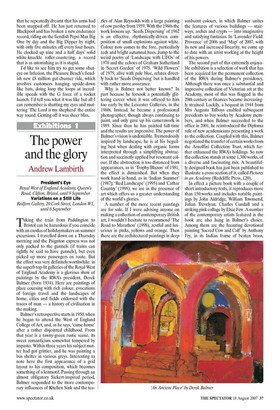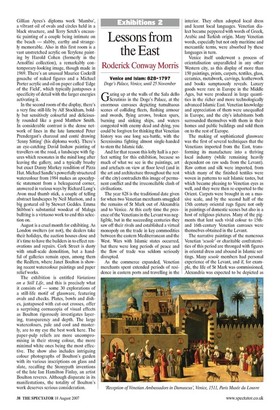The power and the glory
Andrew Lambirth President's Eye Royal West of England Academy, Queen's Road, Clifton, Bristol, until 9 September Variations on a Still Life Redfern Gallery, 20 Cork Street, London Wl, until 6 September Making the train from Paddington to 1 Bristol can be hazardous if you coincide with an exodus of holidaymakers on summer excursions. I travelled down on a Thursday morning and the Paignton express was not only packed to the gunnels (if trains can rightly be said to have gunnels), but even picked up more passengers en route. But the effort was very definitely worthwhile: in the superb top-lit galleries of the Royal West of England Academy is a glorious show of paintings by the RWAs president, Derek Balmer (born 1934). Here are paintings of place coursing with rich colour, evocations of foreign travel and the landscapes of home, cities and fields endorsed with the traces of man — a history of civilisation in the making.
Balmer's retrospective starts in 1950, when he began to attend the West of England College of Art, and, as he says, 'came home' after a rather disjointed childhood. From that year is a tawny-green rustic scene, its sweet romanticism somewhat tempered by impasto. Within three years his subject matter had got grittier, and he was painting a bus shelter in various greys. Interesting to note here the first appearance of a grid layout to his composition, which becomes something of a leitmotif. Passing through an almost obligatory Sickert-inspired period, Balmer responded to the more contemporary influences of Kitchen Sink and the teazles of Alan Reynolds with a large painting of cow parsley from 1959. With the 1960s the work loosens up. 'Seeds Dispersing' of 1962 is an effective, rhythmically-driven composition of small explosions against white. Colour now comes to the fore, particularly reds and bright autumnal hues. Jump to the weird poetry of 'Landscape with UFOs' of 1976 and the echoes of Graham Sutherland in 'Secret Garden' of 1975. 'Wild Flowers' of 1979, alive with pale blue, relates directly back to 'Seeds Dispersing' but is handled with rather more assurance.
Why is Balmer not better known? In part because he forsook a potentially glittering career when it was offered to him too early by the Leicester Galleries, in the 1960s. Instead, he became a professional photographer, though always continuing to paint, and only gave up his camerawork in 1989. Since then he has painted full-time and the results are impressive. The power of Balmer's vision is undeniable. Tremendously inspired by landscape, he is at his beguiling best when dealing with organic forms interpreted through a simplifying abstraction and succinctly applied but resonant colour. If the abstraction is too distanced from appearances, as in 'Trophy/Blazon' of 1981, the effect is diminished. But when they work hand-in-hand, as in 'Indian Summer' (1987), 'Red Landscape' (1995) and `Cathar Country' (1998), we are in the presence of art which offers us a greater understanding of the world's glories.
A number of the more recent paintings are for sale. If I were advising anyone on making a collection of contemporary British art, I wouldn't hesitate to recommend 'The Road to Marathon' (1998), zestful and luxurious in pinks, yellows and orange. Then there are the architectural paintings in deep sunburnt colours, in which Balmer unites the features of various buildings — stairways, arches and crypts — into imaginative and satisfying fantasias. In 'Lavender Field: Provence' of 2006 and 'Map' of 2007, with its new and increased linearity, we come up to date with an artist working at the height of his powers.
The second part of this extremely enjoyable exhibition is a selection of work that has been acquired for the permanent collection of the RWA during Balmer's presidency. Although there was once a substantial and impressive collection of Victorian art at the Academy, most of this was flogged in the 20th century as finances became increasingly strained. Luckily, a bequest in 1944 from Mrs Augusta Talboys enabled subsequent presidents to buy works by Academy members, and when Balmer succeeded to the office in 2001, he reintroduced the Diploma rule of new academicians presenting a work to the collection. Coupled with this, Balmer negotiated the transfer of certain works from the Arnolfini Collection Trust, which further enhanced the RWAs holdings. So now the collection stands at some 1,300 works, of a diverse and fascinating mix. A beautifully designed book has just been published to illustrate a cross-section of it, called Pictures in an Academy (Redcliffe Press, £20).
In effect a picture book with a couple of short introductory texts, it reproduces more than 150 works and includes notable paintings by John Aldridge, William Townsend, Julian Trevelyan, Charles Cundall and a striking pink collage by Elsie Few. A number of the contemporary artists featured in the book are also hung in Balmer's choice. Among them are the haunting devotional painting 'Sacred Cow and Calf' by Anthony Fry, in its Indian frame of beaten brass, Gillian Ayres's diploma work 'Mambo', a vibrant oil of ovals and circles held in a black structure, and Terry Setch's encaustic painting of a couple being intimate on the beach — slabby, earthy and strangely memorable. Also in this first room is a vast unstretched acrylic on Terylene painting by Harold Cohen (formerly in the Arnolfini collection), a remarkably contemporary-looking image, though made in 1969. There's an unusual Maurice Cockrill gouache of naked figures and a Michael Porter acrylic and oil on paper called 'Edge of the Field', which typically juxtaposes a specificity of detail with the larger energies activating it.
In the second room of the display, there's a very fine still-life by Alf Stockham, boldly but sensitively colourful and deliciously rounded like a good Matthew Smith. In considerable contrast is the dense network of lines in the late lamented Peter Prendergast's charcoal and conte drawing 'Jenny Sitting' (his diploma work). There's an eye-catching David Inshaw painting of travellers on the road, a landscape with figures which resonates in the mind long after leaving the gallery, and a typically brushy but exact Danny Markey rendition of Pizza Hut. Michael Sandle's powerfully structured watercolour from 1984 makes an apocalyptic statement from a beleaguered corner, answered in various ways by Richard Long's Avon mud thumb stick, a couple of telling abstract landscapes by Neil Munson, and a big gestural oil by Stewart Geddes. Emma Stibbon's substantial woodcut of Malaga bullring is a virtuoso work to end this selection on.
August is a cruel month for exhibiting. As London swelters (or not), the dealers take their holidays, the auction houses close and it's time to have the builders in to effect renovations and repairs. Cork Street is dusty with small-scale demolition, but a handful of galleries remain open, among them the Redfern, where Janet Boulton is showing recent watercolour paintings and paper relief works.
The exhibition is entitled Variations on a Still Life, and this is precisely what it consists of — some 30 explorations of a still-life motif of glassware, featuring ovals and checks. Plates, bowls and dishes, juxtaposed with cut-out crosses, offer a surprising cornucopia of visual effects as Boulton rigorously investigates layering, transparency and depth. The large watercolours, pale and cool and masterly, are to my eye the best work here. The paper-pulp reliefs are more uncompromising in their strong colour, the more minimal white ones being the most effective. The show also includes intriguing colour photographs of Boulton's garden with its various inscriptions on glass and slate, recalling the Stonypath inventions of the late Ian Hamilton Finlay, an artist Boulton reveres. Although disparate in its manifestations, the totality of Boulton's work deserves serious consideration.













































 Previous page
Previous page